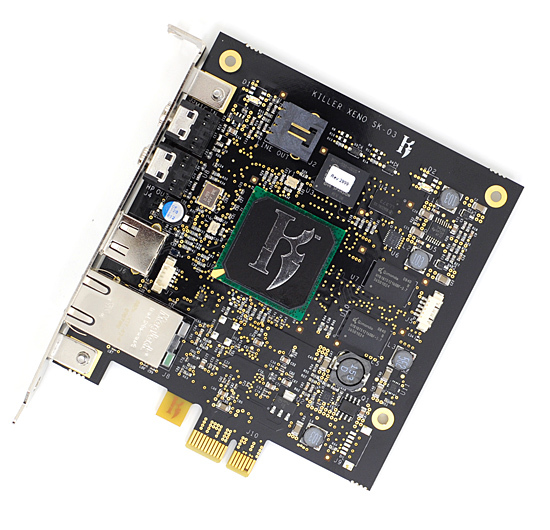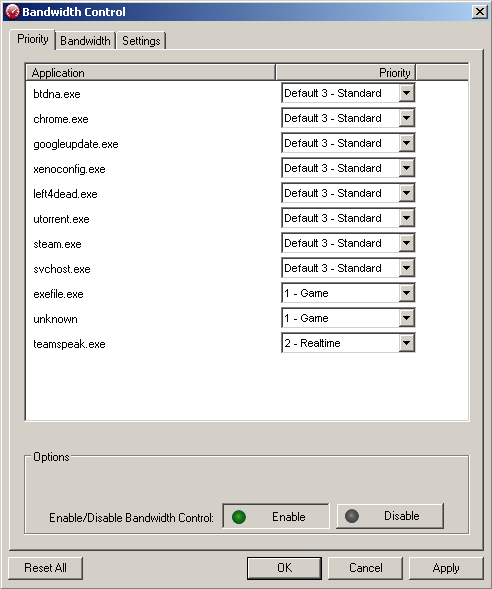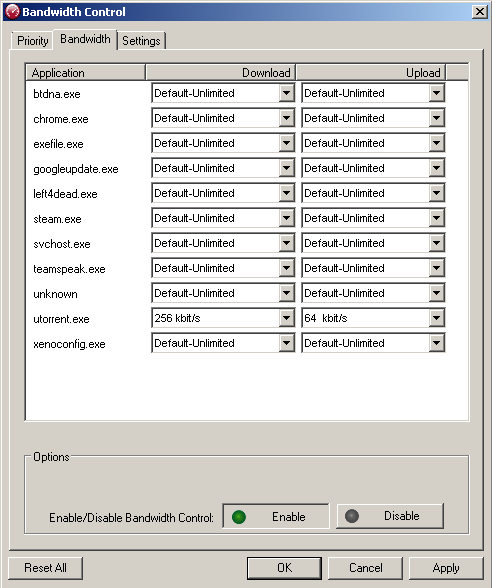EVGA Killer Xeno Pro: The Impact of Network Offloading
by Derek Wilson on July 3, 2009 4:20 AM EST- Posted in
- Networking
The Card and Features
This card sports a 400MHz PowerPC processor with 128MB of RAM, essentially making the Killer Xeno Pro a computer on a x1 PCIe board. As with the first generation, the major feature of the Killer Xeno Pro is it's ability to offload TCP/IP work from the CPU by bypassing the Windows TCP/IP stack.
Microsoft's built-in TCP/IP stack requires the CPU to handle network packet processing. Additionally, when packets arrive, they don't generate interrupts and applications must poll for data (which also wastes time and resources). Bigfoot Networks claims that the windows networking stack is not designed for low latency operation while the Killer Xeno Pro is. Regardless of how (or how efficiently) a software network stack is implemented, having it run in hardware will reduce overhead and impact on the rest of the system. It should also be noted that, for applications which require the windows networking stack (like some VPN products), the Killer Xeno Pro can disable it's "game mode" and enable "application mode" which does disable TCP/IP offload and can increase compatibility in some cases.
Adding to this, the Killer Xeno Pro hardware is capable of offloading other network centric tasks like VoIP, firewalls, and networked storage (though these features are not all fully supported with appropriate software at this point in time).

Installing the hardware is very straight forward, as it's just a simple PCIe card. If you want to use the voice chat features, the only additional need is to connect either the internal or external audio cable. No power is required, and other than that the network port is all that you'll need to worry about. Despite the fact that there is a USB port on the card, it is not used for anything at this point (but Bigfoot has indicated future potential to enable hardware managed USB attached storage).

Mic in and audio line out on a NIC; now that's a first.
The only installation issue we noted is that the driver install, when necessary, will also flash the Killer Xeno Pro hardware. There isn't very much warning about what's going to happen and no confirmation dialog before the start of the flash process. Those who click through install programs quickly without reading them might get themselves into a bit of trouble. There is no way to cancel the flash update once it's started, and while flashing hardware isn't as risky these days, it might be nice if the drivers were a little more clear about what was going to happen.

Easy mode switching.
The hardware comes with drivers and a tray application that are capable of bandwidth throttling and prioritization. Control can be down to a per application basis and maximum download and upload speeds can be specified. Or for benefit without the headache, applications can be prioritized allowing hardware and usage patterns to determine effective bandwidth. Unfortunately, the drivers and applications for the Killer Xeno Pro only run on Microsoft Windows operating systems (XP and Vista flavors). With the gaming focus, this makes sense, but it would still be nice for those who like to dualboot Mac OS X or Linux.

Per application QoS.

Per application bandwidth limits.
With software support, games and voice chat software can completely delegate any VoIP functionality to the Killer Xeno Pro which would handle taking input from the microphone (which plugs straight into the Killer Xeno Pro), compressing the data and sending it out over the network. When a voice packet is received by the Killer Xeno Pro, it decompresses it and sends it straight to the sound card (either via the soundcard's line-in port or an internal cable) bypassing the rest of the system completely. This should help reduce CPU overhead and voice lag caused by sources other than the network or server.
While this is great from a geeky technical standpoint, there isn't a huge amount of overhead on modern CPUs for voice chat software, and the network is by far the largest source of delay. So the actual benefit isn't going to be huge. These issues are the same with hardware firewall, bandwidth control, and all the extras.
The TCP/IP offload capability of the hardware will definitely remove another task from the CPU and operating system. This will free up resources that could be useful for other things, but the real world benefit of this will be very small in most games where the majority of the work is done on the GPU rather than the CPU. Having an NPU (network processing unit, as Bigfoot Networks likes to call it) that handles TCP/IP processing as soon as packets are received and uses hardware interrupts to let a game know that network packets have arrived (rather than requiring polling) can help decrease the latency between when a packet is received by the network card and when a game is able to make use of it, but as with the voice issue the largest delay is inherent in the internet itself and there is only so much benefit that can be had by optimizing the client side.
Not to say that optimizing client side networking is a bad thing: it certainly is not. The real question here is not whether the Killer Xeno Pro does something useful (because it does), the question is whether that useful thing has any significant impact on experience (and if that impact is high enough to justify the price).










121 Comments
View All Comments
james jwb - Friday, July 3, 2009 - link
Integrated NIC's are the de-facto standard in use by Bigfoot's target audience. Almost no one even thinks of looking for an alternative to what comes on there motherboard. We have always assumed the intergrated, free NIC's are more than adequate. This is not the sound card market where in the high-end, people automatically look at add-in boards like the X-fi or Xonar. If Bigfoot wants to sell a number of these cards it's going to have to offer something over the free, integrated NIC's, not add-in cards.This review tells me that for what the average home user does with their PC, it offers pretty much nothing, as most suspected. To me this stinks of an idea that sounded good on paper, in practice failed to deliver any adequate performance increase for the average user, and has only been funded because sometimes bad ideas marketed well can still create profits. Unless Bigfoot can offer something tangible here, I'd honestly like to see them go the way of the dinosaurs (Yes, a big meteor lands on their HQ).
But hey, maybe in the future they can always try the Fatal1ty brand and really go to town :)
Maybe I'm being a bit harsh, but i want something more for my money than marketing and geeky technical spec's for handling something no better (in performance terms) than the boring software TCP/IP stack
Qi - Friday, July 3, 2009 - link
But if no comparison between the Killer NIC and other add-in NICs is made, we don't know which add-in NIC is the best. Also, other add-in NICs are substantially cheaper. Take these for example:Intel Gigabit CT Desktop Adapter
Intel PRO/1000 PT Desktop Adapter
Intel PRO/1000 GT Desktop Adapter
You can get these cards for around $30.
Anonymous Freak - Saturday, July 4, 2009 - link
That's because those cards have the same chip as the onboard Gigabit Ethernet on many Intel-based boards. (Or at least, the same family of chip, with the same features. Deep down, it's probably the same silicon; just named different for the different interfaces.)lyeoh - Sunday, July 5, 2009 - link
Just claiming the cards have the same chip doesn't mean a thing.Lets see better benchmarks against integrated NICs and other add-on NICs. CPU usage, packets per second, throughput, max latency under various conditions.
This review as it is isn't very useful.
In my opinion if you want a better gaming experience you might as well use the extra money to get a fancy router and use it to squish torrent speeds down (and maybe even force torrents to use smaller packets, if you really want lower latency at the cost of throughput).
A smarter router is even more useful if you are sharing the connection with other computers, since it can also help control traffic to those other computers. Whereas this expensive NIC won't help.
mindless1 - Saturday, July 4, 2009 - link
Do you know this factually or are you just guessing? Most boards do not use the same chip, and "family" means little, just a generational grouping. By saying they have the same features you are only saying they all have network features and of course they would.Deep down, saying it's the same silicon would be like saying all silicon is the same, all NICs were identical which they are not.
yyrkoon - Saturday, July 4, 2009 - link
Yeah well, "Those cards" are also the best Ethernet cards out there. They offer ToE, Link Agregrigation, and all the other goodies a network guru would want. I own an Intel Pro 1000 PT, and I can say with confidence that there is no way I am going to spend 6x as much money on a NiC, that will only perform *maybe* as good as the $20 NiC I got on sale.Souka - Saturday, July 4, 2009 - link
Here's a question...I have a c2d mid-level system..using on-board Marvell Yukon 88E8xxx gigabit adapter.
I have an old Intel Pro/1000 GT PCI (not PCI-e) adapter sitting in a box.... would it benifit me to toss it in?
Same question goes for my sound... Should I use, onboard ADI AD1988B 8-channel High Definition Audio CODEC or my old Creative PCI Fata1ity Pro card?
Always apprecaite constructive advice..ideas... :)
Thanks!
yyrkoon - Saturday, July 4, 2009 - link
Maybe, but probably not. The Marvell Ethernet is possibly tied into the PCI-E bus of the motherboard, which means that it *may* not be sharing the bus bandwidth with other peripherals, CPU, and memory; or it could be. The PCI bus is flawed in that way; e.g. it shares bandwidth with all slots, PLUS memory, and CPU. The PCI-E bus in theory is not, but it does not always work that way.The best way to find it is try them both. The Yukon without the PCI card in, and the PCI card with the integrated Ethernet disabled in the BIOS. Myself, I test with the application I have in mind , but you'll probably have many naysayers say something along the lines of "No! you must use this test app" or whatever. Test apps are great if that is all you're going to do ( test ), but if all you want is XX amount of MB/s coming from your XFS + Samba box, well that is all that matters right ?
One thing that I have found out over the course of *many* tests is that file block size can play a big factor in a lot of cases when testing for file transfers with many protocols. A lot of those times, if you pay attention you will see a pattern emerge. The problem here is that disk block sizes are often much larger than your Ethernet card can handle without breaking down into smaller chunks. Anyhow, to keep this reasonably short, unless you're directly transferring from a large RAM disk, you're going to see a performance hit no matter what between disks and Ethernet. That is where ToE is supposed to come into play, but it does not always work as some would have you believe. The idea is that ToE offloads that processing from the CPU keeping your CPU from bogging down. Still there is lots of possible processing going on, so you're likely to still see a performance hit, albeit probably less.
Hope I did not bore you too much . . .
Souka - Sunday, July 5, 2009 - link
not at all...thanks. What you said makes sense.I might play with it when I have some time.
Sound card will be easy to test via game benchmarks/timedemos...but network card I'll probably just use file copy tests if different type/sizes to see how the NIC (onboard vs PCI) makes a difference.
thx again
yyrkoon - Tuesday, July 7, 2009 - link
I would like to add that any add in sound card should perform better than integrated sound. I did a bunch of testing with Oblivion, and even my old 16 bit Sound blaster !live card made about 5 FPS difference. Now, keep in mind that if you have AGP graphics, that this would share the bandwidth from the PCI bus as well . . . So, if all you have is a single sound card using the PCI bus, you *should* be golden. Also, know that PATA HDD's can use the PCI bus for data as well. But typically, if all your peripherals use less than 133MB/s theoretical you should be ok. Theoretical meaning even PCI communications have overhead too, just like Ethernet and the SATA protocols.